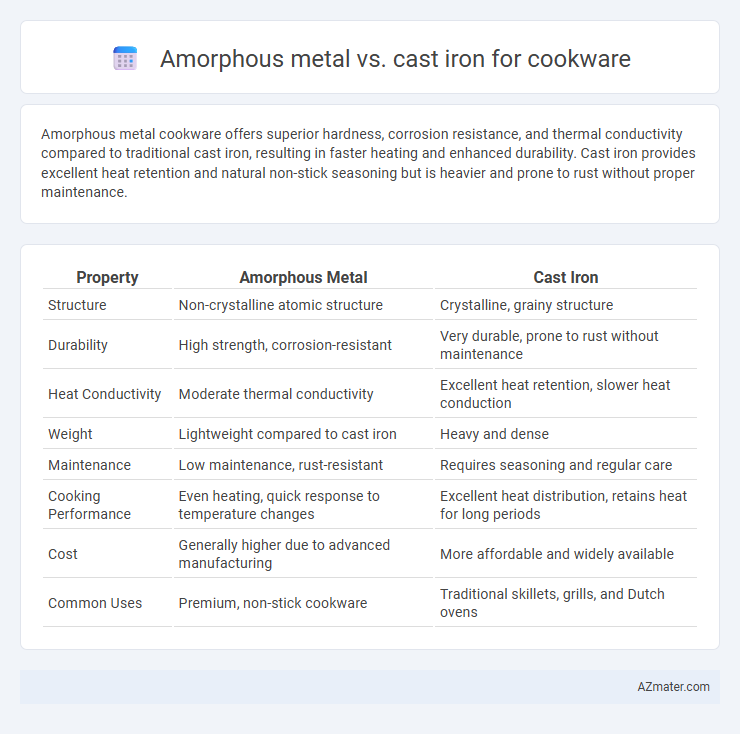Amorphous metal cookware offers superior hardness, corrosion resistance, and thermal conductivity compared to traditional cast iron, resulting in faster heating and enhanced durability. Cast iron provides excellent heat retention and natural non-stick seasoning but is heavier and prone to rust without proper maintenance.
Table of Comparison
| Property | Amorphous Metal | Cast Iron |
|---|---|---|
| Structure | Non-crystalline atomic structure | Crystalline, grainy structure |
| Durability | High strength, corrosion-resistant | Very durable, prone to rust without maintenance |
| Heat Conductivity | Moderate thermal conductivity | Excellent heat retention, slower heat conduction |
| Weight | Lightweight compared to cast iron | Heavy and dense |
| Maintenance | Low maintenance, rust-resistant | Requires seasoning and regular care |
| Cooking Performance | Even heating, quick response to temperature changes | Excellent heat distribution, retains heat for long periods |
| Cost | Generally higher due to advanced manufacturing | More affordable and widely available |
| Common Uses | Premium, non-stick cookware | Traditional skillets, grills, and Dutch ovens |
Introduction to Amorphous Metal and Cast Iron Cookware
Amorphous metal cookware utilizes a non-crystalline alloy that offers exceptional strength, corrosion resistance, and rapid heat conduction, making it a modern alternative to traditional materials. Cast iron cookware is made from molten iron cooled slowly to form a crystalline structure, renowned for its superior heat retention, durability, and natural non-stick seasoning properties. Both materials provide distinct benefits, with amorphous metal excelling in lightweight performance and cast iron favored for its robustness and even cooking surface.
Material Composition and Manufacturing Processes
Amorphous metals used in cookware consist of a non-crystalline alloy structure, typically combining metals like zirconium, titanium, and copper, resulting in superior strength and corrosion resistance. Cast iron is composed mainly of iron with 2-4% carbon and small amounts of silicon, manganese, and phosphorus, produced through casting molten iron into molds. The manufacturing process of amorphous metals involves rapid cooling to prevent crystal formation, enhancing durability and heat distribution, whereas cast iron undergoes slower solidification, creating a crystalline, brittle structure that offers excellent heat retention but requires seasoning to prevent rust.
Heat Conductivity and Distribution
Amorphous metal cookware offers superior heat conductivity compared to cast iron, allowing for faster and more even heating across the cooking surface. Unlike cast iron, which has uneven heat distribution due to its crystalline structure, amorphous metals feature a non-crystalline atomic arrangement that enhances uniform thermal transfer. This results in precise temperature control and reduced hot spots, improving cooking performance and efficiency.
Durability and Resistance to Wear
Amorphous metal cookware exhibits superior durability and resistance to wear due to its non-crystalline atomic structure, which prevents deformation and corrosion more effectively than cast iron. Cast iron, while highly durable and capable of withstanding high temperatures, is prone to rust and chipping if not properly seasoned and maintained. The enhanced wear resistance of amorphous metal cookware ensures longer-lasting performance with minimal surface degradation compared to traditional cast iron.
Weight and Handling Differences
Amorphous metal cookware is significantly lighter than cast iron, making it easier to handle and maneuver in the kitchen. The unique atomic structure of amorphous metal provides strength with reduced density, resulting in a cookware piece that offers durability without the heavy weight typical of cast iron. This weight difference enhances user comfort and reduces fatigue during prolonged cooking tasks.
Cooking Performance: Flavor and Food Release
Amorphous metal cookware offers superior cooking performance with even heat distribution and enhanced non-stick properties, resulting in better flavor retention and easy food release without excessive oil. Cast iron provides excellent heat retention and imparts a distinct flavor, but often requires seasoning to maintain its non-stick capabilities and prevent food from sticking. While cast iron excels in high-heat cooking and flavor development, amorphous metal combines durability with effortless food release, enhancing overall cooking efficiency and taste quality.
Maintenance and Cleaning Requirements
Amorphous metal cookware features a non-porous surface that resists staining and does not require seasoning, making maintenance simple with just mild soap and water. Cast iron cookware demands regular seasoning to maintain its non-stick properties and prevent rust, requiring careful drying and occasional oiling after cleaning. The low maintenance of amorphous metal contrasts with the labor-intensive upkeep of cast iron, appealing to users seeking convenience and durability.
Health and Safety Considerations
Amorphous metal cookware offers superior resistance to corrosion and leaching compared to cast iron, reducing the risk of metal ions contaminating food and ensuring safer cooking for sensitive diets. Cast iron, while durable and naturally non-stick when seasoned, can release iron into food, which may be beneficial in small amounts but poses health concerns for individuals with hemochromatosis or iron overload conditions. The non-crystalline structure of amorphous metals minimizes surface imperfections where bacteria can harbor, enhancing the hygienic quality of cookware over traditional cast iron surfaces.
Price and Market Availability
Amorphous metal cookware typically carries a higher price due to advanced manufacturing processes and limited mass production, making it less accessible compared to cast iron. Cast iron cookware is widely available across various markets and retailers at an affordable price point, appealing to budget-conscious consumers. The premium cost and niche availability of amorphous metal limit its market penetration despite its durability and performance advantages.
Choosing the Best Cookware for Your Kitchen
Amorphous metal cookware offers superior corrosion resistance and a non-stick surface without synthetic coatings, making it highly durable and easy to maintain compared to traditional cast iron. Cast iron provides excellent heat retention and even cooking, but requires seasoning and regular upkeep to prevent rust and maintain its cooking properties. When choosing the best cookware for your kitchen, consider your cooking style, maintenance preferences, and the balance between durability and convenience offered by amorphous metal or cast iron options.

Infographic: Amorphous metal vs Cast iron for Cookware
 azmater.com
azmater.com